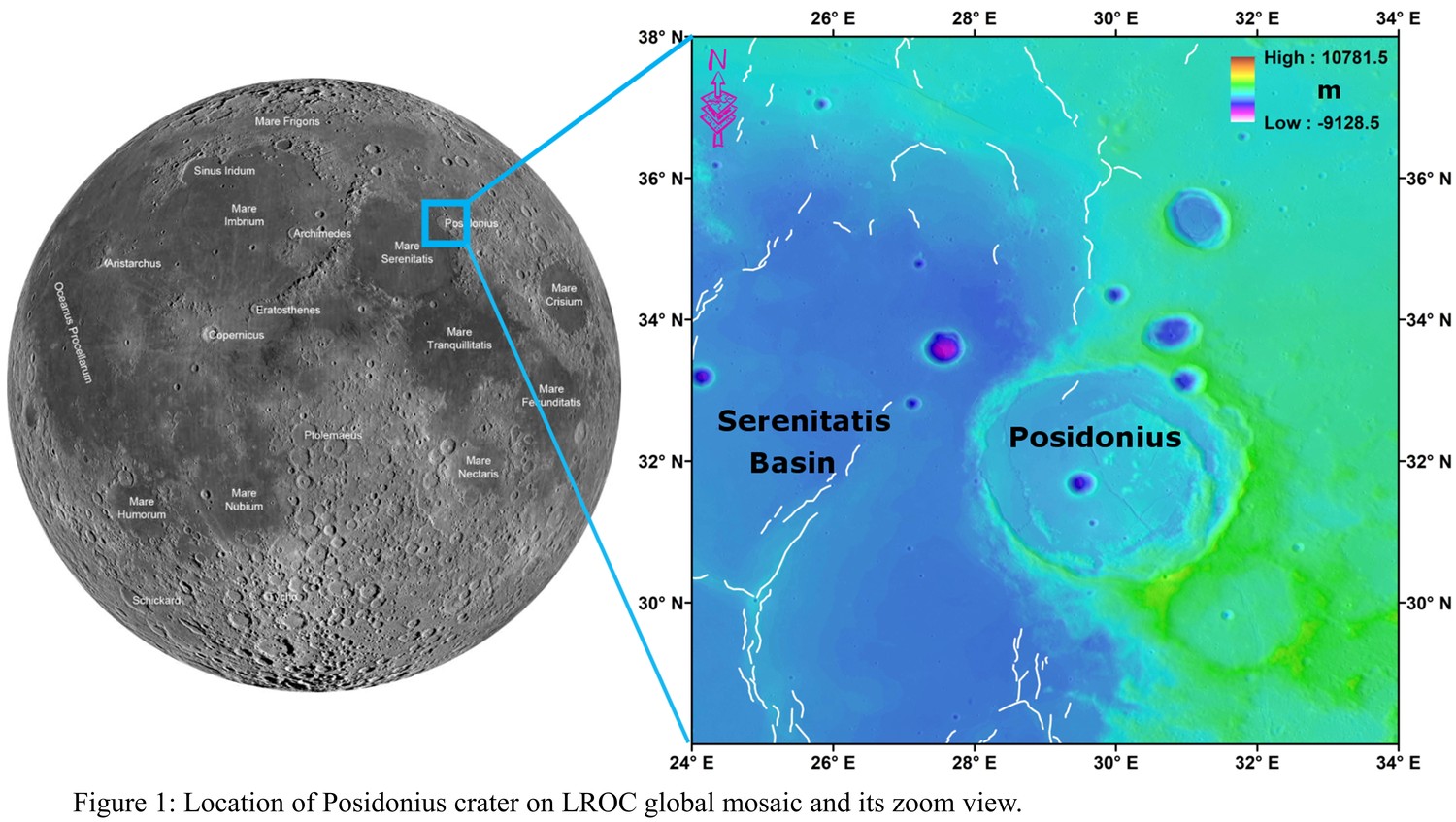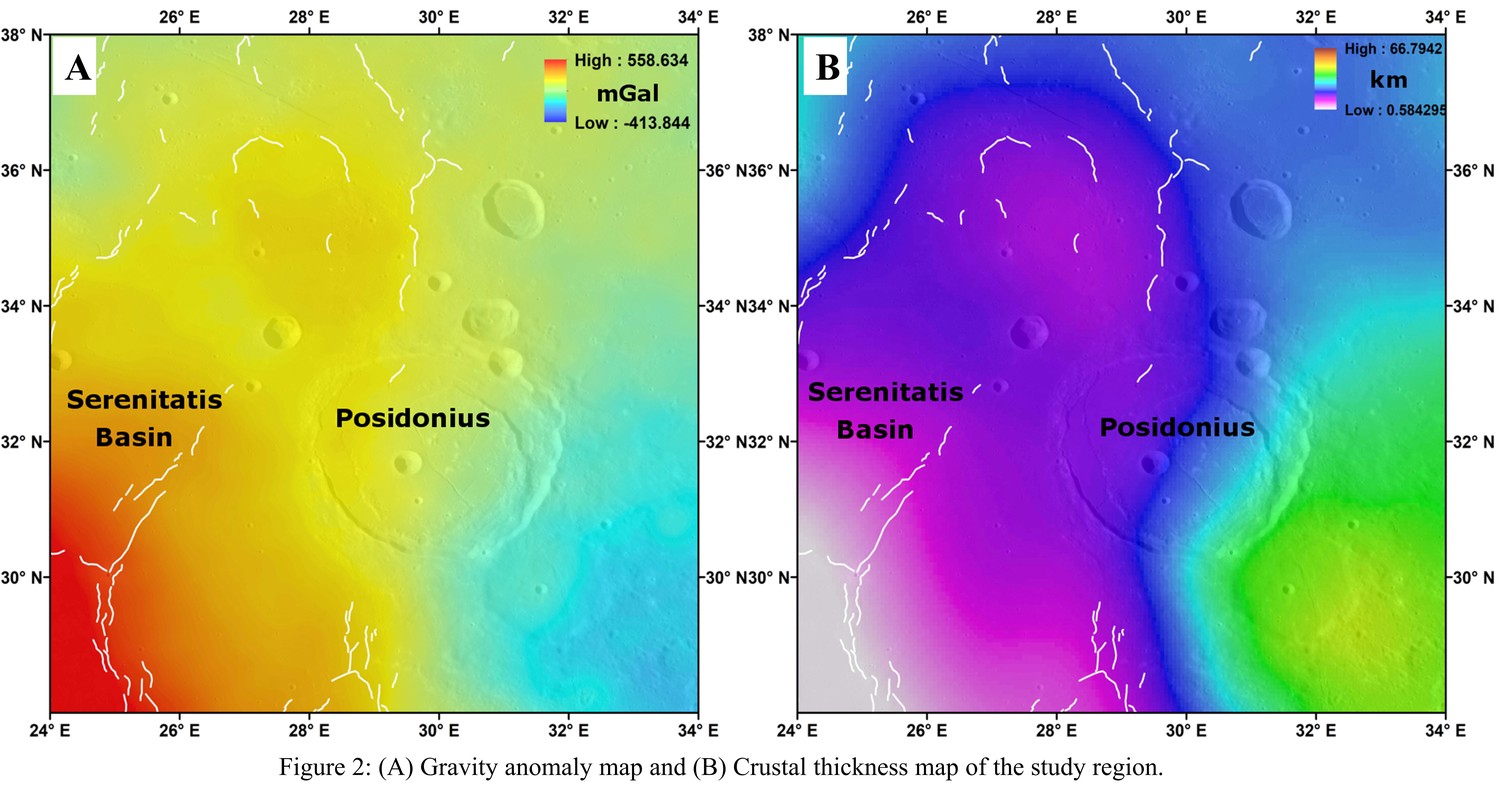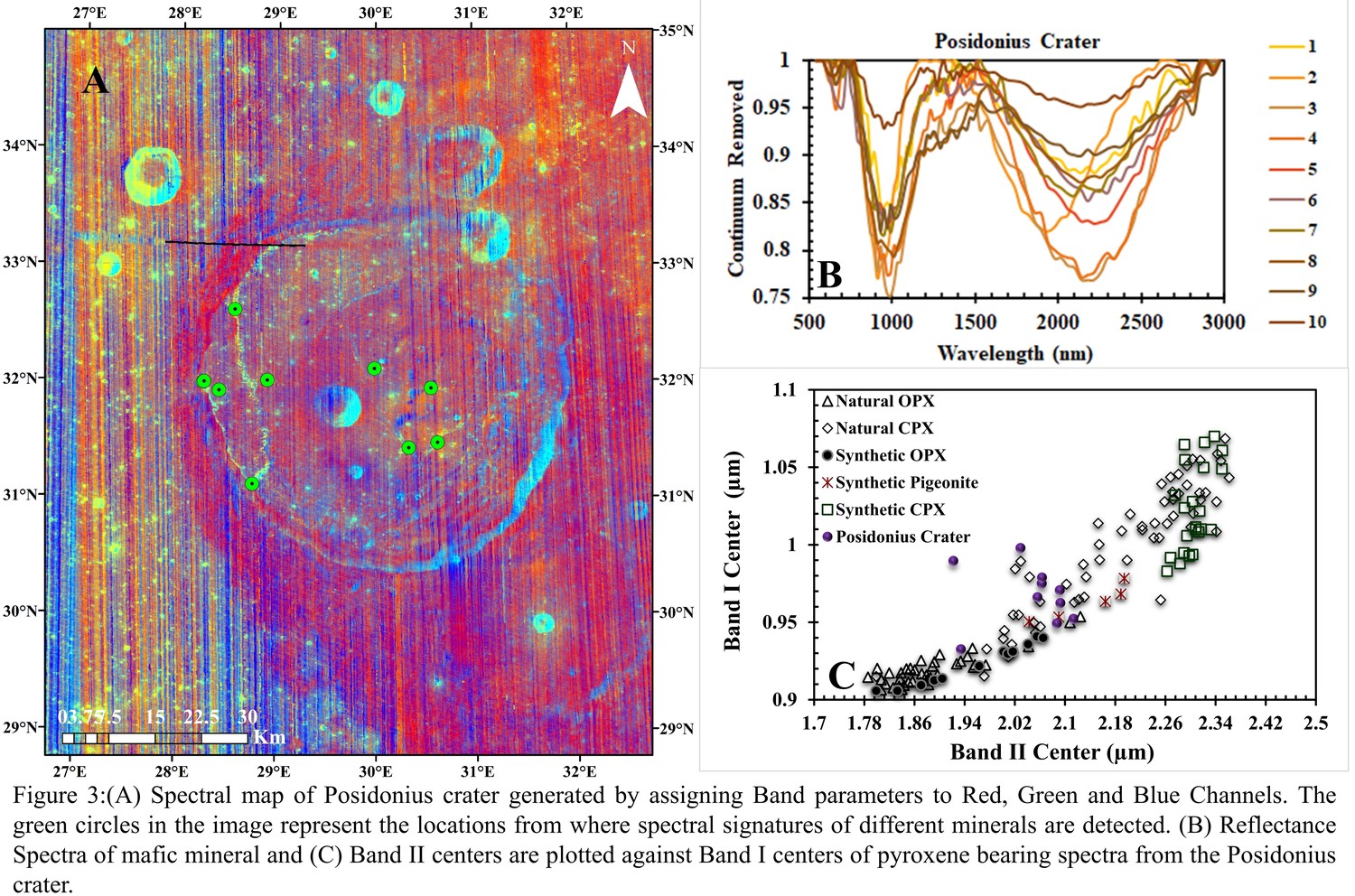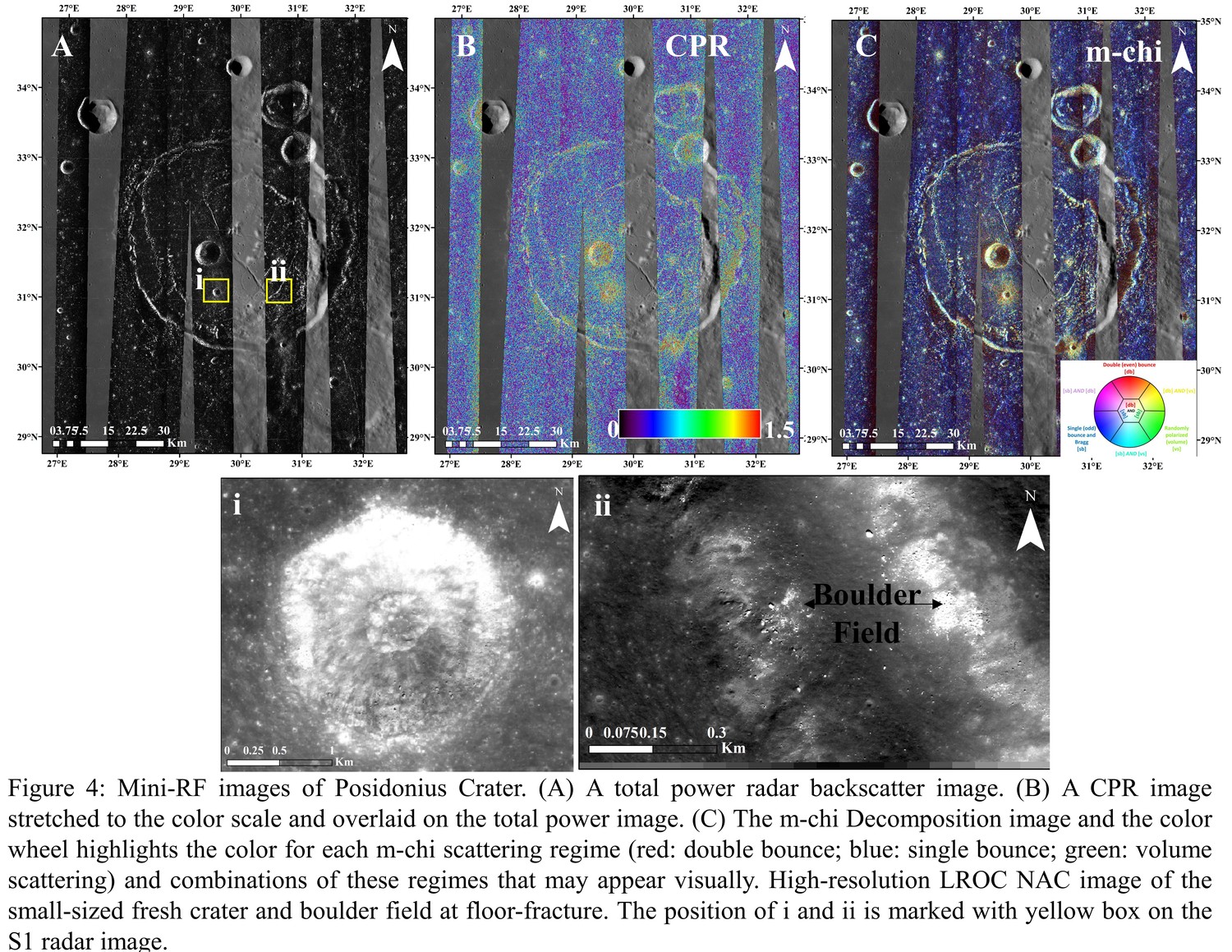Extensive volcanic activity within the Posidonius crater, nearside of the Moon
- 1Space and Planetary Science Center and Department of Earth Sciences, Khalifa University, Abu Dhabi, UAE (shreekumari.patel@ku.ac.ae)
- 2CSIR-National Geophysical Research Institute (CSIR-NGRI), Hyderabad, India
Introduction: Floor-Fractured Craters (FFCs) are unique lunar landforms that have witnessed and recorded tectonic and volcanic activity in the form of distinct structural features [1]. FFCs are common around the edges of mare basins, and their ages span the lunar history [2,3]. They offer insights into the region’s magmatic, thermal and morphological evolution and are candidates for further investigation to comprehend the Moon’s crustal evolution. Therefore, the detailed analysis of FFCs would give new insights into a better understanding of the volcanic activity on the Moon. In connection with this, we selected a Posidonius crater on the nearside of the Moon to perform detailed geological and geophysical analysis to understand the volcanic history.
The Posidonius crater is ~95 km in diameter and is categorised as a Class-III Floor-Fractured crater located on the northeastern rim of the Serenitatis basin [4], with a center latitude and longitude of 31.88°N and 29.99°E as shown in Figure 1. The wide annular depression called moat is noted on the western side of the crater nearest to the exterior Mare Serenitatis plain. The mare infill is divided into two basaltic units by ~180 km long, curvy lava channel known as Rimae Posidonius. The existence of large and small-scale graben and sinuous rille and basaltic infill indicate that tectonic, as well as volcanic processes, deformed the Posidonius crater.

Data and Methodology: The gravity data from Gravity Recovery and Interior Laboratory (GRAIL) of degree and order 660 was used to map the gravity anomalies. The global lunar crustal thickness model-1 was used to see the crustal thickness variations. The composition of the crater and eastern part of Mare Serenitatis was derived using Moon Mineralogy Mapper (M3) onboard the Chandrayaan-1 mission [5]. Band parameters were calculated for mapping first-order mineralogical variation [6]. LRO (Lunar Reconnaissance Orbiter) Mini-RF S-band data was processed to derive CPR and daughter products [7] for the physical characterisation of the study region [8]. LRO NAC (Narrow-Angle Camera) of spatial resolution ~0.5-2 meters/pixel [9] was used to identify and map the structural features.
Results and Discussion:
The gravity anomalies ranged from -413 to 558 mGal (Figure 2A), with high values observed at the outer rim of the Serenitatis basin and low values found at the east, south-east of the Posidonius crater. These anomalies show the decreasing trend towards the northern part of Posidonius crater, indicating that the possible source of volcanic history is the Serenitatis basin. The crustal thickness (Figure 2B) shows low at Serenitatis and Posidonius crater, which suggests the volcanic source is shallow level. Minerals were identified using VNIR spectral characteristics. The crater exhibits exposures of mafic minerals detected from Rimae Posidonius, Floor-Fractures, central peak ring, and mare unit (Figure 3A). Pyroxene spectral shows absorption near 1000 nm and 2000 nm due to Fe2+ and Ca2+ contribution [10]. M3 data suggests that the mare unit is dominated by the subcalcic ferroaugite to Ferroaugite rich rocks such as basalt (Figure 3B and 3C). Spectra of bedrock exposures from rimae and ridge show the presence of magnesium-pigeonite, which suggests the rapid cooling of magma at high temperature. Hence, the enigmatic rimae Posidonius represent the shallow lava flow resulting from a turbulent flow of low-viscosity, high-temperature, rapid cooling lava that erodes the pre-existing mare deposits in Posidonius crater.


Mini-RF Circular Ratio Polarisation (CPR) and m-chi decomposition map of crater display the radar-bright characteristics of tectonic features and small-sized fresh craters. The Posidonius crater exhibits low-CPR values suggesting the maturity scale of the crater. Still, the central peak ring, rimae Posidonius, floor fracture, and small-sized fresh crater show high CPR values due to boulder fields in the vicinity. High-CPR value region represents the mixed scattering of double bounce and volumetric scattering (yellowish hue) as they expose fresh and/or dihedral geometrical surface concentrated at the base or in the vicinity of peak ring, linear/sinuous features, and secondary craters (Figure 4).

Conclusions:
The geological (M3, Mini-RF, and NAC analysis) and geophysical (gravity, crustal thickness) observations in this area revealed extensive eruptions during formation and after formation. It is also observed that the lithospheric loading of the Serenitatis basin influences the origin and modifications of this crater. The detailed analysis and mapping of this region are under process.
Acknowledgements
SP and MRELM acknowledge support for this work through an internal grant (8474000336-KU-SPSC). AVSK is thankful to the director, CSIR-NGRI, Hyderabad, for all the support.
References:
[1] Chauhan, M. et al. (2021) Lunar and Planetary Science Conference (LPSC) 2548, 1843.
[2] Jozwiak, L. M. et al. (2012) JGR:Planets 117(E11).
[3] Jozwiak, L. M. et al. (2015) Icarus 248, 424-227.
[4] Salem, I. B. et al. (2022) Remote Sensing 14(4), 814.
[5] Pieters, C. M. et al. (2009) Current Science, 500-505.
[6] Purohit, A. N. et al. (2021) Journal of Earth System Science 130(1), 1-23.
[7] Raney, R. K. et al. (2012) JGR: Planets 117(E00H21), 1-8.
[8] Patel, S. M. and Solanki, P. M. (2018) Proceedings ACRS, TS70.
[9] Robinson, M. S. et al. (2010) Space Science reviews 150, 81-124.
[10] Klima, R. L. et al. (2011) Meteorite and Planetary Science 46, 379-395.
How to cite: Patel, S., Satyakumar, A. V., and El-maarry, M. R.: Extensive volcanic activity within the Posidonius crater, nearside of the Moon, Europlanet Science Congress 2022, Granada, Spain, 18–23 Sep 2022, EPSC2022-97, https://doi.org/10.5194/epsc2022-97, 2022.

